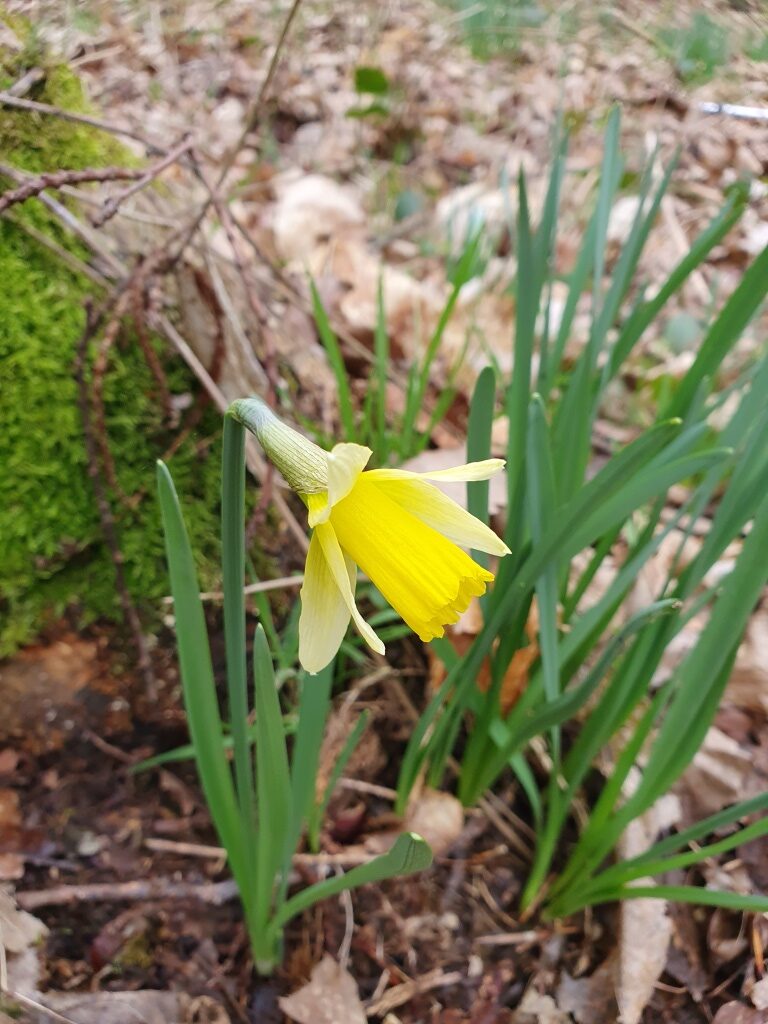Jan Haseler led a walk through Pamber Forest, starting from the Impstone Road car park, on the dull grey morning of Wednesday 13 March. Following weeks of rain, the Forest was sodden, with deep mud in places. The walk started out southwards through Lord’s Wood. This area of woodland, together with the heathland to the south, forms part of the territory of the small herd of Dexter cattle which live all year round on Silchester Common. Sightings here included clumps of Hard Fern, a flower-head of Hairy Wood-rush, the fungus Hairy Curtain-crust Stereum hirsutum and a piece of wood stained green by the Green Elf-cup fungus Chlorociboria aeruginascens. The route led downwards to Silchester Brook, which was crossed by a flat wooden bridge, with an extensive area of deep mud beyond. A gateway then led through the stock fencing which marks the limits of the cattle territory and into Pamber Forest, which is owned by the Englefield Estate, but managed as a nature reserve by the Hampshire and Isle of White Wildlife Trust (HIOWWT). The track led through an area of Sweet Chestnut coppice. It was pointed out that there are no Bluebells in the Forest. Documents from the Englefield Estate archives show that in the last few years of the coppice cycle, gates were left open to allow cattle in to graze, but Bluebells will not tolerate trampling or grazing. The track climbed gently upwards, leading to a sandy area planted with Scots Pine. On the woodland floor was a carpet of Bilberry, with pink flowers visible on a few of the plants. The track led to the main north/south ride which extends along the entire length of the Forest and which has a firm mud-free gravel surface. Heading southwards, a Chiffchaff sang, one of at least three birds which were heard during the course of the walk. The ride was edged with a dense border of Alder Buckthorn, caterpillar food-plant of the Brimstone butterfly. The walk continued southwards, crossing one major ride junction, then turned right at the next junction. This ride had wide, cleared margins and ran past areas which had been recently coppiced. Wood Spurge was coming up densely in a plot which had been cut perhaps two winters ago. The ride led gently downhill to the Honeymill Brook. Flood water had ponded up on the upstream side of the track, but the culvert underneath it had kept the water level below the height of the track. Lesser Celandine flowers brightened up the stream-side vegetation. Another coppice plot had Willows which had been pollarded. Apparently their regrowth is particularly favoured by browsing Roe and Muntjac Deer. As further protection against the deer, all the coppice plots are protected by high stock fencing. Just before the track reached the western boundary of the Forest, a public footpath turned back sharply south-eastwards. It crossed a particularly muddy stretch close to the start which was negotiated with some difficulty. Sightings along the footpath included Barren Strawberry in flower, a new leaf spike of Common Figwort and a Scaly Male-fern. After several more turns, the group reached the part of the Forest where wild Daffodils are found. The grey-green leaves could be seen under the tree canopy over a surprising distance and there was a somewhat sparse display of flowers. Closer inspection showed that there were not many buds still waiting to flower. A later conversation with the reserve manager revealed that there had been a particularly good display of Daffodils last year and he was not surprised that this year’s display was somewhat reduced. After inspecting the Daffodils, the group turned round and retraced their footsteps back to the main north-south ride, then turned eastwards along a ride with wide cleared margins, but where a few trees had been left untouched. Fallen leaves below one of these trees came from a Wild Service-tree. The ride climbed gently uphill and led into the area where the cattle live, crossing the stock fencing at a point where there is a cattle grid with a gate at the side. Two members of the Wildlife Trust staff, including the reserve manager, were using chain-saws to cut down trees at the edge of the track. The route then led northwards across heathland, where a Slow-worm was found resting on the path. It was encouraged to move into the vegetation at the side of the path. The mud at the crossing of the Silchester Brook had to be tackled again. Siskins called from the Alders high overhead. The final part of the walk was back up through Lord’s Wood to the car park. Most of the group then went to the Calleva Arms in Silchester for lunch.

